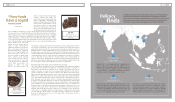Sennheiser 2009 Annual Report Download - page 19
Download and view the complete annual report
Please find page 19 of the 2009 Sennheiser annual report below. You can navigate through the pages in the report by either clicking on the pages listed below, or by using the keyword search tool below to find specific information within the annual report.
37
PRODUC T EXPERIENCE
Teamwork
of the
senses
Even though the brain cannot be disassembled like a clock, researchers
have been able to largely identify exactly which areas of the brain
are responsible for processing the different senses. Still to come: how, where
and when the brain computes the different sensory stimuli and carries
out the multisensory integration.
36 PRODUCT EXPERIENCE
ers have to be able to master the interplay between the senses. Perfumers are almost
never able to put their product messaging across through fragrance alone. Instead, they
use shape and color to trigger associations. Why? It’s difficult to come up with a descrip-
tion for a perfume that resonates with the consumer. So manufacturers use the perfume
bottle, its liquid and product packaging to position brand messaging. Packaging designed
on a multisensory level increases the buyer’s anticipation, allowing him to not only see
the brand he is buying, but also hear, smell and feel it. Italian houseware manufacturer
Alessi designed a cookie box with rounded edges. “Mary Biscuit” feels good, smells of
vanilla extract and produces a softer thump when opened. “But apart from the
comforting sound, it also depends on the context in which it is heard,” says Dr. Janice
Rock, chief engineer at the Institute of Technical Acoustics, RWTH, in Aachen. She cites
an example: the sound of the ocean at the beach can have a calming effect – however,
the same sound in the same volume in a living room would only be perceived as noise.
“Or imagine a silent vacuum cleaner. It
wouldn’t give the perception of high
performance.” To address their custom-
ers on an emotional level, acoustical
engineers optimize a product’s material,
volume, shape and sound transmission.
Added value through tactile stimuli
Increasingly, the sense of touch is also
becoming a focus of multisensory
designers. Even though touch may rank
last among the senses as far as multi-
sensory stimuli is concerned, the skin is,
and remains, our largest organ. For cer-
tain products, the sense of touch can
play a decisive role. For half of all car
buyers, the feel of the steering wheel
and gearshift is a deciding factor in
whether or not they buy a car. And for
more than a third of all mobile phone
buyers, the feel is more important than
its looks. Which is why quality manufac-
turers such as Sennheiser use only the
finest materials. Plastics from the avia-
tion and aerospace industries, and
microfiber textile not only make the
HD800 headphones look good – they
convey a very unique brand feeling. It’s a
little bit like grandma’s cookie jar, only
better. And better throughout.
What principles does Sennheiser follow
when designing its product experience?
As the leading technology provider in the pre-
mier retail and professional audio segments,
Sennheiser has a keen interest in communi-
cating clearly and marketing its own technol-
ogy and product advances. We don’t just de-
velop our own know-how, we also work close-
ly together with design agencies and
technology partners to develop concepts for
ergonomics, material and design, perfor-
mance, unique advantages, perceived value
and innovation.
Aside from acoustics, do visual, tactile or
even olfactory characteristics play a role?
Yes, any one of the “brand senses” able to
influence a product and its appearance can
have an effect on the Sennheiser brand. How
a customer experiences Sennheiser is never
left to chance.
How does it work?
A consumer doesn’t just begin experiencing
a product when he first actually has it in his
hands. The experience starts from the mo-
ment he begins to look at, and touches the
packaging. The surface feel plays a crucial
role. What associations does it bring up? A
strong brand like Sennheiser is associated
with values like tradition, innovation and
quality. The logo on every product is a
guaranty of our attributes, and these high
expectations should never disappoint.
What role does operability play?
The intuitive operation of a product is an im-
portant aspect of branding. However, there
is also a differentiation between retail and
professional audio equipment. Professionals
want more sophisticated equipment. Some-
thing that says, “Only I know how to do
that!”That’s also how we know that they are
equipped for more complex applications.
How do you create an emotional
bond to the product?
The more specifically and uncompromisingly
the product is packaged, the more it polarizes
and the greater emotion it evokes. This emo-
tion can have many different facets – from
the unexpectedness of the product, innova-
tion, materials used, lightweight design or size.
ACOUSTICAL PERCEPTION
BALANCE
SIGHT
LINGUISTIC UNDERSTANDING
TASTE
HEARING
SMELL
ARTICULATION
COMPLEX REACTIONS
SPATIAL PERCEPTION
BODY MOVEMENT
TOUCH
POSTURE
Intelligent interaction: Just walking upright
requires the brain to process information
from four of the senses: balance, touch, spa-
tial perception and sight.
Maurice Quarré, Director of Product Lifecycle Management,
Sennheiser Consumer Electronics GmbH, on product experience
“The sensory experience
is not left to chance.”
























